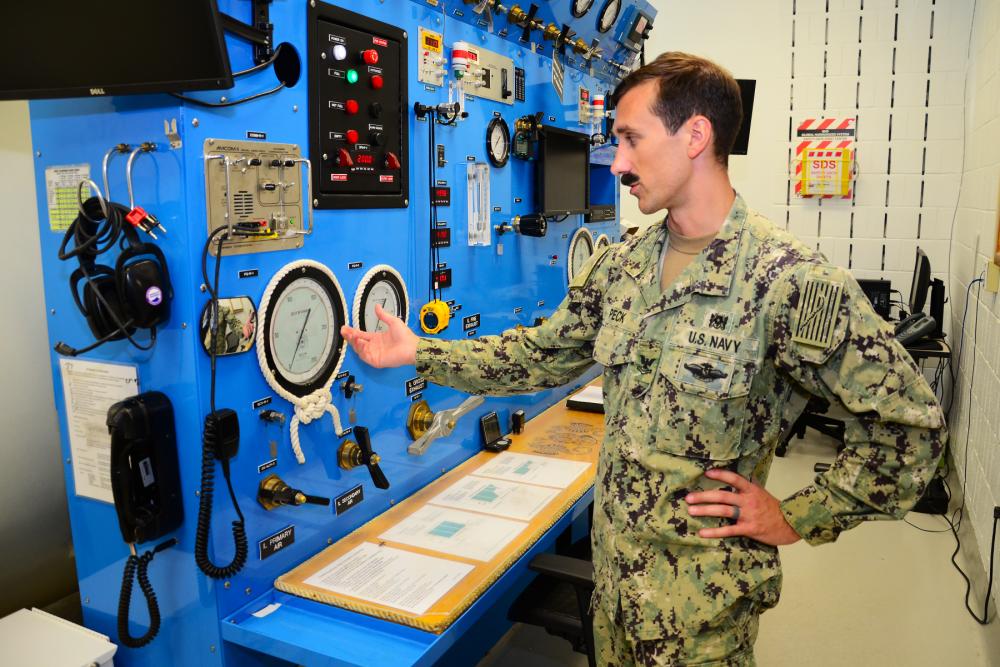
Photo By Joshua Cox | Hospital Corpsman 2nd Class Evan Peck, a member of the Naval Aerospace Medical Institute (NAMI) Hyperbaric Medicine team, points out the depth gauge of the recompression chamber on NAS Pensacola, June 14, 2022. The recompression chamber is used in hyperbaric medicine, and can treat many injuries and conditions with the patient receiving oxygen or oxygen blends while in the chamber. U.S. Navy photo by Joshua
It is not uncommon for scuba divers to develop adverse injuries and medical conditions while underwater. Decompression sickness, also known as the bends, is the most common diving injury.
“Scientists figured out that the decompression sickness is caused by nitrogen bubbles coming out of solution in the bloodstream,” said Capt. Henry F. Casey III, M.D., department head, Naval Aerospace Medical Institute (NAMI) Hyperbaric Medicine Department. “If you spend time at depth, you actually onboard gases like nitrogen.” After a diver reaches 99 feet, nitrogen becomes toxic and divers can literally become intoxicated while underwater.
Capt. Casey compared it to be basically being drunk underwater, after 99 feet, and making tragic decisions that ultimately could lead to a diver’s death.
“So the decompression sickness problem is when people come up too fast from depth, those nitrogen bubbles come out of solution too fast and our normal scrubbing system, which is our lungs, gets overwhelmed and those nitrogen bubbles go all over the body. If you come up too fast, you’re going to get bubbles — so, ‘bubbles is troubles.’”
It was more than 100 years ago when the term “the bends” was given to divers who experienced so much pain after diving that they couldn’t stand up straight.
“You have people come up and they can’t walk, and they sometimes are so bad, it looks like they have had a stroke” Casey said. “Really bad decompression sickness will kill you.”
It’s also been more than a century ago since hyperbaric oxygen therapy was invented, as an initial way to treat decompression sickness in scuba divers.
“Scientists figured out how to build a chamber to pressurize that person back down to a depth where those bubbles go back into solution,” Casey said. “It’s a recompression chamber — we recompress people. It’s basically a Coke can on its side, and we pump air into it to bring it down to whatever depth we need to treat the patient”.
Casey compared the hyperbaric oxygen therapy to “a dry scuba dive”.
“Physiologically they’re scuba diving, but they’re not wet,” Casey said. “The Navy decided to have these hyperbaric chambers placed where operational dives are.”. The NAMI Recompression Chamber on NAS Pensacola supports many units, agencies and activities in the area, including special operations commands, the Coast Guard and other units conducting diving, training and naval flight operations. “On any given day, we’re probably supporting up to 500 people doing operational training or missions,” Casey said. “So, we’re on standby for that group of people.”
“Our job is to treat pressure-related injuries,” Casey said. “The pressure-related injury usually ends up being the bends, so that’s what our chamber is here to do. That’s what all Navy chambers around the world do — they support Navy diving and naval aviation.”
Casey said the recompression chamber can be used for naval aviators who need treatment. For example, if an aviator experiences a significant change in pressure during an altitude-related event in flight, they can develop decompression sickness and may need to utilize the NAMI recompression chamber and the experts who treat pressure-related injuries.
Hospital Corpsman 2nd Class Evan Peck, who is on the NAMI recompression chamber team, said the recompression chamber is also used in hyperbaric medicine, and can treat many additional injuries and conditions with the patient receiving oxygen or oxygen blends while in the chamber.
“Oxygen is the most important medication that we have,” Peck said. “There’s some dangers to the oxygen therapy when we put (patients) under pressure. But, the Navy has been working with this for a long time. We’ve got a lot of good research on it, and we’ve been one of the leading groups in the world.”
Casey said The NAMI Recompression Chamber is the only hyperbaric chamber in the Navy accredited by the civilian Undersea and Hyperbaric Medical Society (UHMS). The medical community relies on the UHMS for guidance on the safety and effectiveness of hyperbaric oxygen therapy for specific diseases and conditions.
“The idea is to bring people down to pressure, put them on oxygen and that oxygen gets absorbed into the body,” Casey explained. “Oxygen is a very healing substance. So, the hyperbaric oxygen therapy is great for wound care as well as DCS.”
The hyperbaric medicine team here can treat air or gas embolisms, bone infections, diabetic foot wounds and even certain types of poisonings. In all, the hyperbaric chamber on NAS Pensacola can treat 14 conditions and injuries in patients.
We can treat different emergencies like carbon monoxide poisoning, Casey said.
“We can put people in the chamber and we can flood them with oxygen, and that helps move that poison out,” Casey explained. “Sometimes there’s a blood clot that gets stuck in the eye and it will cause blindness,” he added. “But we can bring people here and treat that.”
Whether a Navy diver surfaces from the Gulf with the bends, or a DoD retiree needs treatment for a bone infection, the NAMI recompression chamber team is ready to support and treat patients with this extraordinary and innovative medical technology.
Cited by, read more at DVIDS
